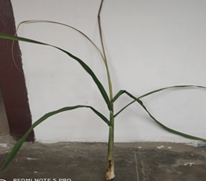Shoot Borer
Shoot Borer
The shoot borer is widely distributed in all sugarcane growing areas in India, infesting the crop during its early stages of growth in spring or autumn planted crop. It occurrence of pests are during the period March to June. It infest heavily during drought or scanty rainfall. High temperatures and low to moderate humidity favored borer activity.
Damage Symptoms
• Central whorl of leaves dries up and forming dead hearts.
• Dead hearts of infested plant can be pulled out easily.
• Rotten portion of straw emits offensive odor.
• A number of feeding punctures near the base of shoot.
• The infection starts just after germination and continue up to June
• Borer attack during the germination stage kills the mother shoots.
• Resulting in the drying up of the entire clump, creating gaps in the field.
Management
• Early planting should be followed to avoid synchrony between the susceptible crop stage and peak borer activity period.
• Two to three light earthing-up and trash mulching operations should be given during the early stages of the crop growth.
• Removal of dead heart at fortnightly interval.
• Intercropping of sugarcane with coriander, onion and garlic, potato and green gram, depending on planting season, reduces shoot borer incidence.
• Installed pheromone traps one month after planting @ 25 ha with monthly change one lure help to reduce moth population.
• Egg parasitoid Thichogramma chilonis sequential releases @ 50,000 /ha at 10 days interval beginning 30 days after planting during April-June would be useful.
• Apply Fipronil 0.60 % GR @12.5kg/ha at time of planting.
• If pest attack severe condition in standing crop may apply Flubendiamide 20 % WG @375gm/ha followed by light irrigation.



